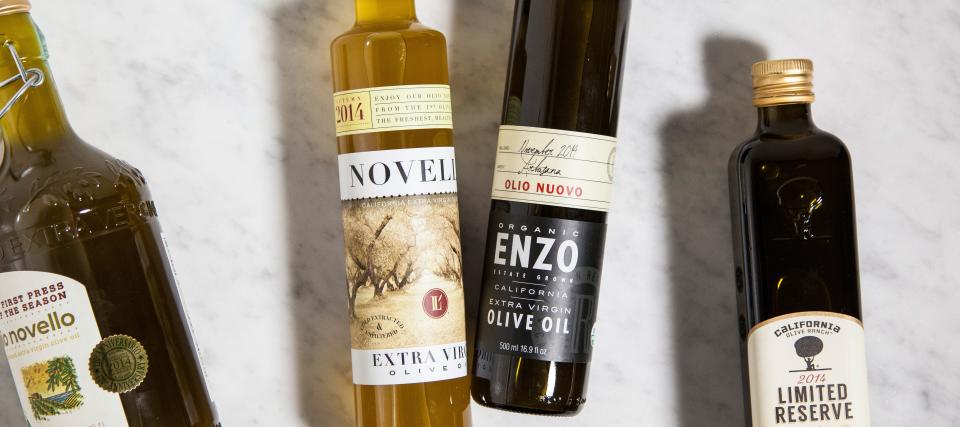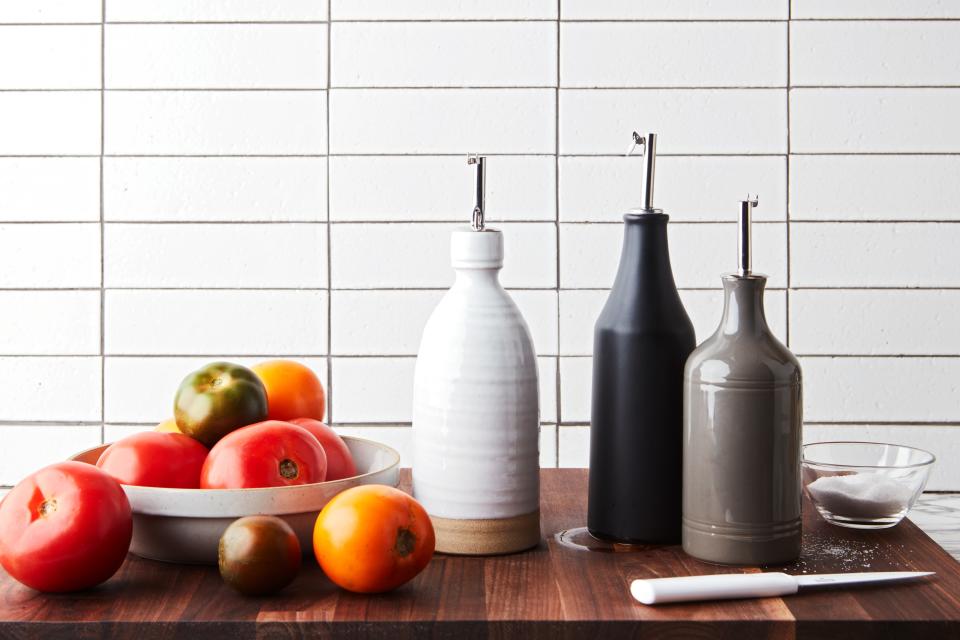How to Shop for Olive Oil
It's easy to see why everyone is continually confused about how to shop for olive oil. You've heard the stories: that the extra virgin olive oil you're cooking with isn't authentic, that it's mixed with inferior oils, that it's all a scam.
This is how to buy and store olive oil so it tastes as good as possible—for as long as possible.
And, well, it's not entirely unwarranted. Fraud and mislabeling in the olive oil world has been well documented. It's top of mind for the North American Olive Oil Association, the trade group for olive oil producers in the United States. The association runs authenticity testing on olive oils at the retail level, using criteria set out and monitored by the granddaddy International Olive Council, based in Madrid.
A big part of the problem for American consumers is lack of federal regulation. The USDA standard for olive oil isn't mandatory, so a producer can but doesn't have to pursue certification showing its extra virgin oil is legit. And given that 98 percent of the olive oil sold in the United States comes from somewhere else (mostly Spain and Italy, but also Greece, Turkey and Tunisia), that makes for a lot of unknowns.
Panicked yet? Don't be. There's a lot of good—and real—olive oil out there. For guidance, we turned to Eryn Balch, NAOOA's executive vice president, and to the website Truth in Olive Oil, run by journalist Tom Mueller, author of the book Extra Virginity: The Sublime and Scandalous World of Olive Oil. Here’s their best advice on how to buy olive oil.
Where to shop
The upside to shopping at a specialty olive oil store is that such purveyors do their research. You can rely on knowledgeable staff and taste before you buy.
But the more likely scenario is at the supermarket, so buy where you know there's high turnover. Dust collecting on bottles isn't an encouraging sign.
No hoarding
Olive oil doesn't get better with age. The real stuff is essentially fruit juice, Mueller writes. Buy what you know you'll use within two months, Balch said.
Dark and cool
Olive oil has three enemies: heat, light and air. It'll go rancid pretty quickly when overexposed to any of those, so opt for oil in dark glass bottles or in tins, Balch said.
At home, keep the oil sealed, out of sight and away from the stove.
Go EVOO
Choose "extra virgin olive oil" over that labeled simply "olive oil" or "light olive oil." It's the purest, least processed and most flavorful type.
Extra virgin olive oil is made by crushing olives and separating the liquid from the solids, then taking that liquid and separating out the oil from the water. It's a mechanical process involving no heat or chemicals, Balch said.
What's labeled olive oil or light olive oil goes through a refining process due to some defect—an off odor or low-quality fruit.
"You're basically left with an odorless, flavorless oil," Balch said.
You get what you pay for
The old adage generally rings true in this case. Making extra virgin olive oil is an expensive process. While the priciest isn't always the best, be wary of bargain-bin oils (less than $10 a liter is Mueller's benchmark.)

olive oil bottles on marble background
Photo by David CicconiRead the label
It's worth knowing which details to take note of and which are basically meaningless.
“Best by” date. It's a good sign if you see this date, which isn't required by federal law. For most producers, the "best by" date is one to two years from when the oil was bottled, Balch said. The further out the date, the fresher the oil.
Harvest date. This date is more meaningful if you're familiar with different olive oil-producing regions and seasons and know what you’re looking for. Nonetheless, it's good to see a harvest date; even better if it's from the current year's harvest, according to Mueller.
Country of origin. The FDA requires that the country of origin—meaning where the olives are from and where the oil was made—be listed. You can usually find it on the back near the nutrition facts panel. Unless you see a specific estate name on the label, know that there's often more than one country involved. "A lot of big volume producers will buy oil from various parts of the Mediterranean region and then will blend them," Balch said.
"Bottled in," "Packed in," "Imported by." Don't equate these with where the oil was actually made. Italy bottles a lot of oil made in other countries.
"Cold pressed" or "first cold pressed." This is pure marketing, said Balch. All extra virgin olive oil is cold pressed, meaning no heat was applied during the process. There's no second pressing. And besides, the more accurate term these days is "extracted," not "pressed."
Certification seals. Seals such as the European Union's Protected Designation of Origin or Italy's DOP offer a certain level of assurance that the oil was made properly in a specific region by traditional methods, according to Mueller.
Ultimately, our experts say, it’s a matter of tasting around and figuring out what you like. There’s an incredible range of olive oils out there, from mild and fruity to surprisingly robust. And there’s no fooling your taste buds.
Here are a couple of our favorite olive oils to try:
Fruity and Buttery Sicilian Olive Oil
Frankies Organic Extra Virgin Olive Oil, 16.9 Fluid Ounces
$20.00, Amazon
Grassy, Peppery California Olive Oil
While it's not generally advisable to buy olive oil in bulk, buying a bag in box olive oil (like boxed wine) keeps the olive oil fresher for longer since it prevents exposure to light and oxygen. If you're going to buy olive oil in bulk, opt for bag-in-box.
Seka Hills Premium Extra Virgin California Olive Oil 3 Liter Bag in Box
$67.00, Amazon
Originally Appeared on Epicurious




